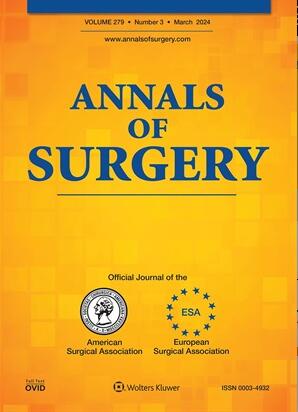Living Donor Liver Transplantation reduced Waitlist Mortality in Acute-on-chronic Liver Failure.
IF 6.4
1区 医学
Q1 SURGERY
引用次数: 0
Abstract
OBJECTIVE To compare intention-to-treat (ITT) and post-transplant outcomes of living donor liver transplant (LDLT) and deceased donor liver transplant (DDLT) in patients with acute-on-chronic liver failure (ACLF). SUMMARY BACKGROUND DATA Limited data exist comparing LDLT and DDLT outcomes in ACLF, particularly addressing waitlist mortality. METHODS Retrospective analysis of all ACLF patients listed for transplant (2008-2023). Patients with living donors were categorized as intention-to-treat LDLT (ITT-LDLT) group and others as ITT-DDLT group. Primary outcome was to compare ITT-overall survival (ITT-OS), defined as survival from listing to death. Secondary outcomes included waitlist outcomes, post-transplant complication and long-term survival. RESULTS 270 patients were accepted for transplant (ITT-LDLT n=127, ITT-DDLT n=143) with similar clinical characteristics at listing. ITT-LDLT achieved superior ITT-OS, with 92.9% survival at 3 months vs. 67.1% for ITT-DDLT (P<0.001), driven by higher transplant rates (94.5% vs. 53.8%, P<0.001) and shorter waiting times. ACLF grade 2 and 3 patients had the greatest survival benefit in ITT analysis. Futile waitlist outcomes, defined as death or delisting were more common in ITT-DDLT (4.7% vs. 35.7%, P<0.001). Post-transplant outcomes were comparable; 30-day mortality (2.0% vs. 1.0%, P=0.62), severe complication (28.6% vs. 33.3%, P=0.47) and 5-year survival (74.5% vs. 74.7%, P=0.46). Even for ACLF grade 2 and 3, LDLT achieved a 5-year survival at 87.2% and 68.0% respectively. Older age, higher ACLF grade and ITT-DDLT predicted waitlist futility. Neither ACLF grades nor transplant type predicted graft survival. CONCLUSION ITT-LDLT improved ITT-OS especially in ACLF grade 2/3 cohort and provided similar perioperative and long-term outcomes to DDLT.活体供体肝移植降低了急性慢性肝衰竭的等待名单死亡率。
目的比较急性慢性肝衰竭(ACLF)患者活体供肝移植(LDLT)和死亡供肝移植(DDLT)的意向治疗(ITT)和移植后结局。背景数据目前比较LDLT和DDLT在ACLF中的结果的数据有限,特别是关于等候名单死亡率的数据。方法回顾性分析2008-2023年所有ACLF移植患者。活体供体患者分为意向治疗LDLT组(ITT-LDLT)和ITT-DDLT组。主要结局是比较itt -总生存期(ITT-OS),定义为从上市到死亡的生存期。次要结果包括等候名单结果、移植后并发症和长期生存。结果入选时临床特征相似的移植患者270例(ITT-LDLT 127例,ITT-DDLT 143例)。由于更高的移植率(94.5%对53.8%,P<0.001)和更短的等待时间,ITT-LDLT获得了更好的ITT-OS, 3个月生存率为92.9%,而ITT-DDLT为67.1% (P<0.001)。ITT分析显示,ACLF 2级和3级患者的生存获益最大。无效的等待名单结果,定义为死亡或摘牌在ITT-DDLT中更常见(4.7% vs. 35.7%, P<0.001)。移植后的结果具有可比性;30天死亡率(2.0%比1.0%,P=0.62)、严重并发症(28.6%比33.3%,P=0.47)和5年生存率(74.5%比74.7%,P=0.46)。即使对于2级和3级ACLF, LDLT的5年生存率分别为87.2%和68.0%。年龄越大,ACLF评分越高,ITT-DDLT预测候选名单无效。ACLF分级和移植类型均不能预测移植物的存活。结论itt - ldlt改善了ITT-OS,特别是在2/3级ACLF队列中,并提供了与DDLT相似的围手术期和长期预后。
本文章由计算机程序翻译,如有差异,请以英文原文为准。
求助全文
约1分钟内获得全文
求助全文
来源期刊

Annals of surgery
医学-外科
CiteScore
14.40
自引率
4.40%
发文量
687
审稿时长
4 months
期刊介绍:
The Annals of Surgery is a renowned surgery journal, recognized globally for its extensive scholarly references. It serves as a valuable resource for the international medical community by disseminating knowledge regarding important developments in surgical science and practice. Surgeons regularly turn to the Annals of Surgery to stay updated on innovative practices and techniques. The journal also offers special editorial features such as "Advances in Surgical Technique," offering timely coverage of ongoing clinical issues. Additionally, the journal publishes monthly review articles that address the latest concerns in surgical practice.
 求助内容:
求助内容: 应助结果提醒方式:
应助结果提醒方式:


